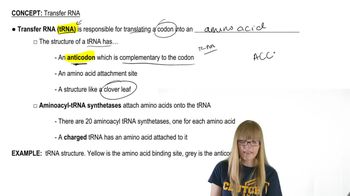Table of contents
- 1. Introduction to Genetics51m
- 2. Mendel's Laws of Inheritance3h 37m
- 3. Extensions to Mendelian Inheritance2h 41m
- 4. Genetic Mapping and Linkage2h 28m
- 5. Genetics of Bacteria and Viruses1h 21m
- 6. Chromosomal Variation1h 48m
- 7. DNA and Chromosome Structure56m
- 8. DNA Replication1h 10m
- 9. Mitosis and Meiosis1h 34m
- 10. Transcription1h 0m
- 11. Translation58m
- 12. Gene Regulation in Prokaryotes1h 19m
- 13. Gene Regulation in Eukaryotes44m
- 14. Genetic Control of Development44m
- 15. Genomes and Genomics1h 50m
- 16. Transposable Elements47m
- 17. Mutation, Repair, and Recombination1h 6m
- 18. Molecular Genetic Tools19m
- 19. Cancer Genetics29m
- 20. Quantitative Genetics1h 26m
- 21. Population Genetics50m
- 22. Evolutionary Genetics29m
5. Genetics of Bacteria and Viruses
Bacterial Conjugation
Problem 5b
Textbook Question
Explain the importance of the following features in conjugating donor bacteria: the origin of transfer
 Verified step by step guidance
Verified step by step guidance1
Understand that bacterial conjugation is a process where genetic material is transferred from a donor bacterium to a recipient bacterium through direct contact.
Recognize that the 'origin of transfer' (oriT) is a specific sequence on the plasmid DNA in the donor bacterium where the transfer of DNA begins.
Note that the oriT is crucial because it is the site where the relaxase enzyme makes a single-strand nick in the DNA, initiating the transfer process.
Acknowledge that the presence of oriT ensures that the DNA transfer is directional and starts at a specific point, allowing for efficient and accurate transfer of genetic material.
Realize that without the oriT, the conjugation process would not be able to initiate, making it an essential feature for the successful transfer of genetic material during bacterial conjugation.
Recommended similar problem, with video answer:
 Verified Solution
Verified SolutionThis video solution was recommended by our tutors as helpful for the problem above
Video duration:
3mPlay a video:
Was this helpful?
Key Concepts
Here are the essential concepts you must grasp in order to answer the question correctly.
Conjugation
Conjugation is a process of horizontal gene transfer in bacteria, where genetic material is transferred from a donor to a recipient cell through direct contact. This mechanism is crucial for the spread of traits such as antibiotic resistance and metabolic capabilities among bacterial populations. Understanding conjugation helps elucidate how genetic diversity is generated in microbial communities.
Recommended video:
Guided course

Conjugation Overview
Origin of Transfer (oriT)
The origin of transfer (oriT) is a specific DNA sequence in the plasmid of donor bacteria that is recognized by the conjugation machinery. It serves as the starting point for the transfer of genetic material during conjugation. The presence and functionality of oriT are essential for successful gene transfer, as they determine the efficiency and specificity of the conjugation process.
Recommended video:
Plasmids
Plasmids are small, circular DNA molecules that exist independently of chromosomal DNA in bacteria. They often carry genes that confer advantageous traits, such as antibiotic resistance or virulence factors. In the context of conjugation, plasmids typically contain the oriT sequence, enabling their transfer between bacteria, which plays a significant role in the evolution and adaptability of bacterial species.
Recommended video:
Guided course

R Plasmid

 4:06m
4:06mWatch next
Master Conjugation Overview with a bite sized video explanation from Kylia Goodner
Start learning


